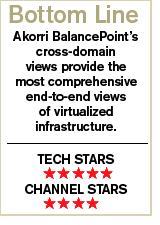Review: Cross-Domain Monitoring

The tools that come with VMware infrastructure solutions such as VirtualCenter and some other third-party monitoring tools are too VMware-focused. These tools only trace activity inside virtual server hosts and do not follow the I/O path of applications across domains. The outputs are difficult to link to other monitoring tools.
The problem of stitching data between tools runs even deeper. Administrators with knowledge of a virtualized domain need to understand how other domains are being managed. For instance, to track application performance, administrators managing virtualized servers need to be aware of changes made to storage domain configurations by other administrators. If administrators cannot measure the impact of changes made to physical and virtual pathways, it becomes extremely difficult for them to identify bottlenecks.
In addition, the technical language and references used by managers with different domain expertise are not the same. But even if language is not a problem, administrators working in different domains have different objectives. Those managing virtual servers mainly focus on minimizing server sprawl and maximizing density of server farms. Storage managers are more concerned with distributing resources across different storage arrays.
To gain visibility into virtualized layers, CRN Test Center recommends Akorri's BalancePoint, a unique cross-domain monitoring solution that can map applications across virtual hosts and virtualized storage environments. BalancePoint provides realtime analytical information of applications across multiple silos. In addition, BalancePoint can produce maps of the applications as they exist and interact across physical devices and virtual environments. The software is now able to provide recommendations on how to improve problem areas.
Akorri sells BalancePoint as a network appliance. The software is agentless, so it works by collecting server data from remote protocols such as WMI and SSH. The agentless connection makes the implementation process quite easy. Solution providers only need to identify devices and systems running on a network and allow BalancePoint to reach them over standard network protocols. BalancePoint can collect data from SMI-S, which is a protocol for storage arrays. Through SMI-S, the software can collect complete storage schemas and configurations of SANs. Since application performance is the information of most value, BalancePoint is also able to connect to application protocols and collect information on internal resources used by components.
Once connected, BalancePoint's database starts to collect information and grow. Akorri has trademarked the phrase "application fingerprint" to mean measuring of application workload over virtual environments. The data collected is part of a baseline that is then used by its analytical processes to run performance projections and make recommendations.
Rather than compete with VirtualCenter or other tools, BalancePoint complements them. By providing consolidated views of applications running on VMware, the visibility of these other tools is increased.
Next: The Bottom Line The BalancePoint resource map is a treasure trove. By traversing a connection map, managers can trace physical and virtual environments and the links between them. The links are derived from application connections into virtualized environments, data resources and physical devices. Without the visibility BalancePoint provides in these maps, test results can quickly turn into a guessing game.
Akorri sells BalancePoint as a network appliance. The software is agentless, so it works by collecting server data from remote protocols such as WMI and SSH. The agentless connection makes the implementation process quite easy. Solution providers only need to identify devices and systems running on a network and allow BalancePoint to reach them over standard network protocols. BalancePoint can collect data from SMI-S, which is a protocol for storage arrays. Through SMI-S, the software can collect complete storage schemas and configurations of SANs. Since application performance is the information of most value, BalancePoint is also able to connect to application protocols and collect information on internal resources used by components.

Once connected, BalancePoint's database starts to collect information and grow. Akorri has trademarked the phrase "application fingerprint" to mean measuring of application workload over virtual environments. The data collected is part of a baseline that is then used by its analytical processes to run performance projections and make recommendations.
Rather than compete with VirtualCenter or other tools, BalancePoint complements them. By providing consolidated views of applications running on VMware, the visibility of these other tools is increased.
The BalancePoint resource map is a treasure trove. By traversing a connection map, managers can trace physical and virtual environments and the links between them. The links are derived from application connections into virtualized environments, data resources and physical devices. Without the visibility BalancePoint provides in these maps, test results can quickly turn into a guessing game.